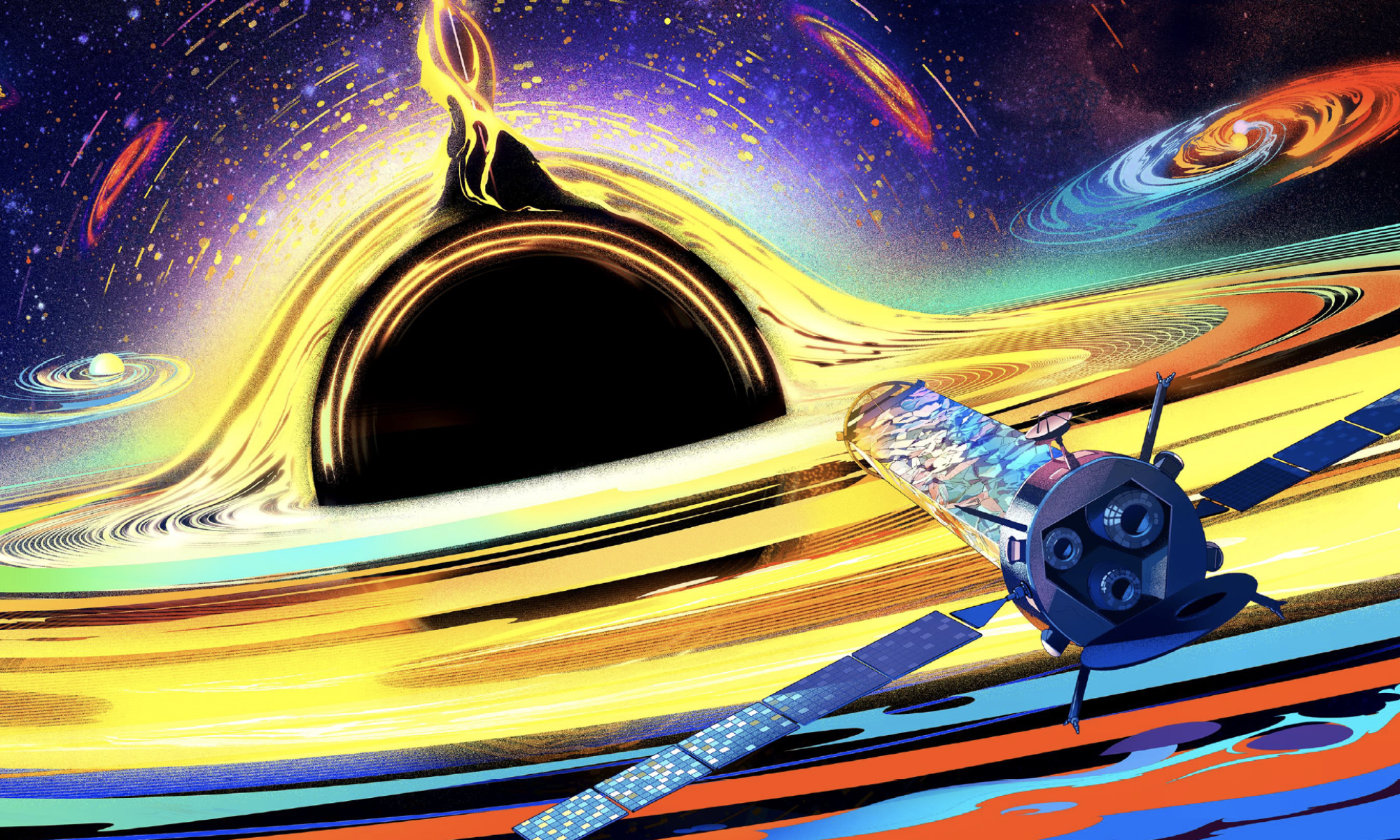About
Across the Universe there are mysteries whose secrets are encoded across three orders of magnitude in X-ray energy and more than nine orders in time. As black holes and neutron stars tear apart companions, the accreting matter shines brightly in X-rays from 0.1 to 100 keV. Broad spectral features tell the story of the interacting system and how it formed. Elsewhere in our Universe, extreme events are occurring as stars explode into their recent ejecta, merging neutron stars create ripples in the cosmic fabric, and stars are shredded as they plunge into black holes. And behind it all, billions of active galactic nuclei (AGN) sum together to produce the cosmic X-ray background that peaks at 25 keV. When resolved into individual sources, their spectra tell the story of whether each AGN is enshrouded in dust and gas, how fast its supermassive central black hole is spinning, and whether it is producing feedback from a powerful outflow. These phenomena vary on timescales of milliseconds to millennia, so decoding their secrets requires simultaneous broadband observations that span the entire X-ray range.
The High Energy X-ray Probe (HEX-P) is a proposed Probe-class NASA mission designed to unravel these mysteries.
Additional information about the HEX-P mission design and science are presented in a special issue of Frontiers in Astronomy and Space Sciences titled: “High-Energy Astrophysics Research Enabled By The Probe-Class Mission Concept HEX-P”.
Science
The baseline mission is five years with 30% of the observing time dedicated to the PI-led program and 70% to a GO program. The GO program will run alongside the PI-led program, and all data will be made available without proprietary time.
Image: NGC 253. With significantly better angular resolution and nearly an order of magnitude improvement in sensitivity at high energies, HEX-P will resolve compact object populations in nearby galaxies.
Additional Science
At least 70% of the HEX-P 5-year prime mission science observations will be allocated as a General Observatory (GO), with competitively selected programs selected through an annual peer-review process. The GO program will enable science far beyond the Goal and Objective science planned by the Science Team, and the following science working groups investigated some such capabilities.
Instrument

The HEX-P payload consists of a suite of three co-aligned X-ray telescopes designed to cover the 0.2 — 80 keV bandpass. The High Energy Telescope (HET) has an effective bandpass of 2-80 keV, and is composed of two High Energy Mirror Assemblies (HEMAs), which utilize thin electroformed Ni shells coated with Pt/C and W/Si multilayer coatings for high energy response. These focus onto two High Energy Detector Assemblies (HEDAs), which are photon counting CdZnTe hybrid detectors based on the NuSTAR design. The Low Energy Telescope (LET) has an effective bandpass of 0.2-20 keV and is composed of a Low Energy Mirror Assembly (LEMA) optimized for improved spatial resolution that capitalizes on Si segmented mirror technology developed at the NASA Goddard Space Flight Center. The LEMA focuses onto the Low Energy Detector Assembly (LEDA), which utilizes a Depleted P-Channel Field Effect Transistor (DEPFET).
The three Wolter type I (Wolter-I) telescope mirror assemblies are mounted to a Northrop Grumman three-axis stabilized spacecraft bus that serves as the base for a three-sided, coilable boom, extended after launch to place the detector bench at a focal length of 20 m. The coilable boom is enclosed in a thermal Kapton sock to suppress stray-light and bremsstrahlung activation of the boom components by solar X-ray flux. The boom deploys with an array of three aperture stops to mitigate stray-light from sources outside the field-of-view and the cosmic X-ray background.
For more information about the HEX-P instrument and mission profile, see Madsen et al. (FrASS, submitted;arXiv:2312.04678).
TEAM
HEX-P Leadership
Principal Investigator (PI): Daniel Stern (JPL/ Caltech)
Deputy PI: Kristin K. Madsen (GSFC)
Associate PI: Javier Garcia (GSFC)
JPL Capture Team
Capture Lead: Miles Smith
Deputy Capture Lead: Sharon Kedar
Payload Systems Engineer: Patrick Morrisey
Mission Systems Engineer: Rashied Amini
Key Partners
Managing Center: Jet Propulsion Laboratory
LET optics: Goddard Space Flight Center
LET detectors: Max Planck Institute for Extraterrestrial Physics
HET optics: Italian Space Agency
HET detectors: Caltech
SIXTE simulations: Dr. Karl Remeis-Observatory
Spacecraft + Structures: Northrop Grumman
Science Team Co-Investigators
Matteo Bachetti (INAF-Cagliari)
Stefano Bianchi (University of Rome)
Murray Brightman (Caltech)
Esra Bulbul (MPE)
Francesca Civano (GSFC)
Joel Coley (Howard University)
Melania Del Santo (INAF-Brera)
Laura Di Gesu (ASI)
Chris Fragile (Charleston College)
Suvi Gezari (STScI)
Brian Grefenstette (Caltech)
Fiona Harrison (Caltech)
Giorgio Lanzuisi (INAF-Bologna)
Bret Lehmer (University of Arkansas)
Raffaella Margutti (UC-Berkeley)
Andrea Merloni (MPE)
Alberto Moretti (INAF-Brera; PI for Italian Effort)
Kaya Mori (Columbia University)
Kirpal Nandra (MPE; PI for German Effort)
Kerstin Perez (Columbia University)
Gabriele Ponti (INAF-Bologna)
Peter Predehl (MPE)
Simonetta Puccetti (ASI)
Arne Rau (MPE)
Andrea Santangelo (University of Tübingen)
Daniele Spiga (INAF-Brera)
John Tomsick (UC-Berkeley/SSL)
Dominic Walton (University of Hertfordshire)
Joern Wilms (University of Erlangen)
William Zhang (GSFC)
Key Science Team Collaborators
HEX-P has benefitted from significant science contributions from people outside the list of co-I’s, including >200 co-authors on the refereed HEX-P science papers that appear in Frontiers of Astronomy and Astrophysics. This is an incomplete list of some key collaborators who have taken on leadership roles for sub-topics and/or led HEX-P science papers:
Marco Ajello (Clemson)
Jason Alford (NYU)
Peter Boorman (Caltech)
Riley Connors (Villanova)
Thomas Dauser (Erlangen)
Elias Kammoun (Univ. of Rome)
Renee Ludlam (Wayne State University)
Lea Marcotulli (Yale)
Matt Middleton (Southampton)
Giovanni Pareschi (INAF-Brera)
Katja Pottschmidt (UMBC/CRESST)
Ryan Pfeifle (George Mason University)
Joanna Piotrowska (Caltech)
Steve Reynolds (North Carolina State University)
Dan Wilkins (Stanford)
Anne Lohfink (Montana State University)

